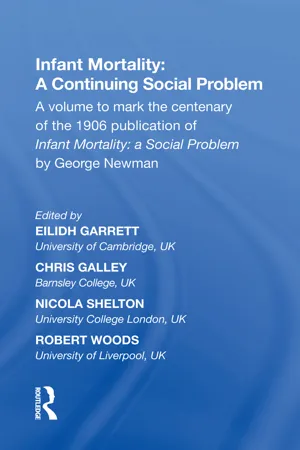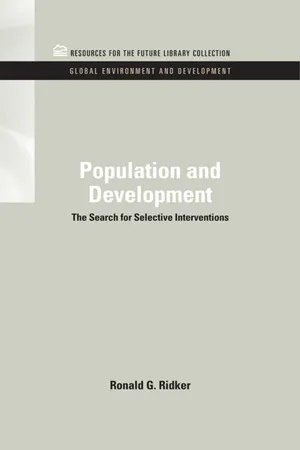Geography
Infant Mortality Rate
Infant Mortality Rate refers to the number of deaths of infants under one year of age per 1,000 live births in a given population. It is a key indicator of a region's overall health and well-being, reflecting factors such as access to healthcare, nutrition, sanitation, and socioeconomic conditions. High infant mortality rates often indicate underlying social and economic challenges within a community.
Written by Perlego with AI-assistance
Related key terms
4 Key excerpts on "Infant Mortality Rate"
- eBook - ePub
Population Geography
A Systematic Exposition
- Mohammad Izhar Hassan(Author)
- 2020(Publication Date)
- Routledge India(Publisher)
maternal mortality rate. In the developed countries, maternal mortality rate/ratio is generally very low, while in the less developed parts of the world, due to poverty, lack of adequate health care facilities and ignorance, maternal mortality rates/ratios are very high. India reports one of the highest maternal mortality ratios in the world.Infant Mortality Rate (IMR) is a measure of mortality among infants. Infants include babies who are less than one year of age. Infant Mortality Rate is defined as the ratio between the infant deaths in a calendar year and the number of live births recorded in that year. This rate is computed in the following manner:IMR =(11.6)(K)D 0/ B- where D0 is the number of infant deaths during a calendar year, B is the total live births recorded in that year and K is 1,000.
Infant Mortality Rate is one of the most sensitive indicators of medical and health care facilities in a population. In fact it is a very good indicator of the levels of social and economic development of a population. Several empirical studies have indicated a positive relationship between IMR and birth rates in different populations, and hence IMR is taken as an important parameter to understand the mechanism of fertility change in a population (Misra, 1982:141). However, it may be noted that IMR does not refer to the risk of death of a cohort of babies born during a particular time. This is because some of the infant deaths included in the numerator might relate to the birth cohort of the previous year, and some infant deaths of the birth cohort in question (i.e. the denominator) might occur in the following year. Therefore, the measure is not a proper rate but a ratio (Srinivasan, 1998:89). Infant deaths attributable to some external factors like accidents or infections are called exogenous infant mortality. Likewise, the occurrence of deaths among infants due to some congenial malformation and birth trauma is called endogenous infant mortality. Infant mortality is further grouped into neonatal mortality and post-neonatal mortality - eBook - ePub
- Chris Galley(Author)
- 2018(Publication Date)
- Routledge(Publisher)
Infants are the most vulnerable members of society, they rely exclusively on others for their survival and hence the rate at which they perish is often taken to be a critical measure of that society's wellbeing. According to Newman (1906: 1). 'A low rate, other things being equal, indicates a healthy community, a high rate the reverse' and, with the IMR being simple to calculate, it is frequently used as a surrogate for a wide variety of social, environmental and medical indicators. During the nineteenth century, as the science of vital statistics developed, information about births and deaths became readily available and it gradually began to emerge that, with the exception of the very old, infants were subjected to the greatest risk of dying. Moreover, once the considerable spatial variations in infant mortality were revealed, it was obvious that many infant deaths were preventable and an increasing number of concerned individuals began to investigate the reasons why so many infants did not survive their first year. Despite these efforts the IMR remained high and by the early twentieth century, with the birth rate declining and notions of national deterioration to the fore, infant mortality developed into an issue of national importance (see Chapter 2). As Newman was writing Infant Mortality the IMR in England and Wales was still over 150, which represented a considerable drain on national resources. In 1905 'there was a loss to the nation of 120,000 dead infants in England and Wales alone, a figure which is exactly one quarter of all the deaths in England and Wales in that year' (Newman, 1906: 2). However, unbeknown to Newman, the IMR had already begun a decline that would continue throughout the twentieth century (Figure 1.1). Newman's book was therefore written at an interesting and significant turning point in demographic history - IMRs were still horrendously high, but they were just beginning to be brought under control - eBook - ePub
In Excellent Health
Setting the Record Straight on America's Health Care
- Scott W. Atlas(Author)
- 2013(Publication Date)
- Hoover Press(Publisher)
CHAPTER THREE Infant Mortality as an Indicator of Health and Health CareVirtually all national and international agencies involved in statistical assessments of health status, health care and, more broadly, economic development use the Infant Mortality Rate, and rely on it heavily, as one of their key indicators. The list includes some of the most respected organizations in the world, such as the World Bank, the World Health Organization, UNICEF, the United Nations, the U.S. Department of Health and Human Services, the Centers for Disease Control and Prevention, the Agency for Healthcare Research and Quality, the Central Intelligence Agency, and innumerable others.1 The infant mortality statistic is granted especially high prominence relative to other measures in all international assessments of health, as well. For example, the Organization for Economic Cooperation and Development (OECD) assesses “Quality of Life” and relies on just three indicators: life expectancy, infant mortality, and obesity in its Factbook. 2 This highly esteemed international organization also selects infant mortality as one of only sixteen key tables for its OECD Health 2010 data. Similarly, the Agency for Healthcare Research and Quality (AHRQ) includes infant mortality among only eight mortality measures it tracks, four of which are cancers, to compile its National Index of Health (most recently in 2010).3 The CIA’s World Factbook , published for almost seventy years including its predecessor programs, bases its widely cited “Country Comparisons” on six main categories, and in the “People” category, infant mortality is one of only twelve subcategories listed, and then ranked worldwide.4 Some authors even go so far as to proclaim that, “Infant mortality is the single most comprehensive indicator of the level of health in a society.”5Simple logic also dictates that infant mortality should be a legitimate reflection of health care for several reasons. Births, whether routine or complicated, occur in and out of hospitals so they reflect the availability as well as quality of medical care; newborns are among the most vulnerable to life-threatening illness; infants are regularly seen by doctors in sickness and for scheduled medical check-ups; and diseases of infants run the gamut from common traumas and illnesses that require emergency but straightforward treatment to severe diseases with serious complications and high fatality rates that require complex medical care. It is clear that infants encounter the medical system frequently, and it is inarguable that medical care and access to it have significant impact on infant survival. - eBook - ePub
Population and Development
The Search for Selective Interventions
- Ronald G. Ridker(Author)
- 2013(Publication Date)
- RFF Press(Publisher)
Table 8-6 . Ratio of Children Ever Born (CEB) and Children Alive (CA) in Rural and Urban Areas by Ages of MothersInterregional Comparisons
Since vital statistics are collected and often published according to civil administrative units, these subnational regions are frequently the unit of observation in empirical research on the determinants of, and trends in, demographic phenomena.46 In early studies in Germany (Geissler 1885) and the Netherlands (Verijn-Stuart 1902) the fact that birth and death rates varied together across regions is documented. Verijn-Stuart, in his Dutch study, attempted to hold personal income level constant by grouping twenty rural communities without industrial employments into four wealth classes. Comparing the poorest and richest rural areas, the (live) birth rate was 26 percent greater in the former than in the latter. According to the mortality figures reported, the number of children reaching the age of five would have been only 11 percent greater in the poor community than in the rich community. This evidence suggests that socioeconomic differentials in fertility might be due in part to class differences in mortality.47 Evidence for regions of Amsterdam also conformed to this pattern.A number of recent investigators have also sought to explain inter-regional differences in fertility in terms of mortality and socioeconomic factors. Birth rates in Puerto Rico across municipalities in 1894-97 and 1951-57 are positively associated with earlier death rates (T. Paul Schultz 1967). In the more recent period, for which registration of vital events is virtually complete, death rates lagged one and two years help to explain birth rates; the magnitude of this time-series cross-sectional relationship indicates that birth rates are sufficiently depressed in localities where death rates are low to yield lower rates of natural population increase.48 ’49
Learn about this page
Index pages curate the most relevant extracts from our library of academic textbooks. They’ve been created using an in-house natural language model (NLM), each adding context and meaning to key research topics.



